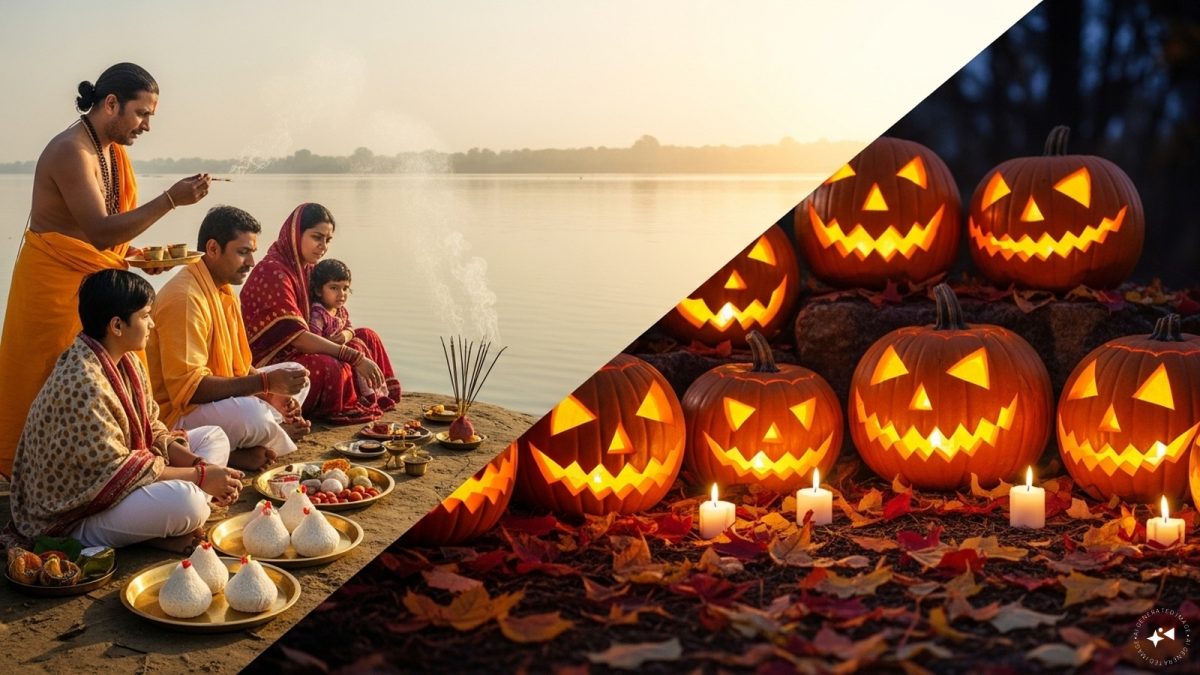Last Updated:
Halloween traces its roots to the ancient Celtic festival of Samhain, when people left out food, drinks for wandering souls, lit candles to guide them, marking the end of summer

Both Pitru Paksha and Halloween share a deep food symbolism, offerings of meals honour ancestors and spirits, turning simple dishes into a bridge between the life and afterlife (Image: AI photo)
In the town of Rajpipla, Gujarat, the banks of the Narmada shimmer under the September sun. Here, for generations, the Joshi family has led Shraddha rituals, the heart of Pitru Paksha. Pandit Ramesh Joshi, the elder priest, now performs them with his grandson seated beside him, just as his own father once guided him.
Every autumn, two distinct yet spiritually aligned traditions unfold but “seven seas” apart. In India, Pitru Paksha marks a fortnight of rituals honouring ancestors through prayers, daan (donations) and food offering rituals. In the West, October ends with Halloween, traced back to the Celtic festival of Samhain, a night devoted to remembering the dead and celebrating the cycle of life and afterlife.
At the heart of both traditions lies a common essence of food rituals. From kheer and ‘pind daan’ on the ghats of Indian rivers to loaves and soul cakes once left out for spirits in medieval Europe, nourishment becomes the language of remembrance.
What Does Pitru Paksha Really Mean?
For Hindus, ‘Pitru Paksha‘ literally, the “fortnight of the forefathers”, follows the lunar calendar and usually falls between September and October. The rituals revolve around gratitude, lineage, and liberation of ancestral souls. Offerings known as tarpan and pind daan are made near water bodies, often rivers like the Narmada or Ganga.
“Our family has done this for over two decades,” Pandit Joshi says, his tone steady with familiarity. “Every man learns from the one before him. During Shraddha, we offer kheer, til, and pind made of rice and barley to our ancestors. Food is not only an offering; it is a remembrance. It says, we have not forgotten you.”
He pauses to chant a small prayer, while sharing his experience, “When we cook kheer during Pitru Paksha, we make it with care, but we do not taste it because it belongs to those who came before and so people do daan and offer bhog to the needy, even crows and cows. You never know in what form your ancestors show up”
The foods chosen is deliberately simple, vegetarian, and unspiced. They symbolise purity and detachment. “Rice, sesame, milk, and ghee are common because they are sattvic” Joshi explains. “They do not excite the senses. This is not a feast, it is prayer through food.”
Is Halloween More Than Trick-Treat and Costumes?
In the windswept landscapes of ancient Ireland, another ritual once unfolded in a similar spirit. Long before Halloween became a carnival of carved pumpkins and sugar, it was Samhain, a Gaelic festival marking the end of harvest and the beginning of winter.
It was believed that on this night, spirits returned to visit their homes. Families left out food and drink for wandering souls, lit candles to guide them, and gathered to share stories of the departed. Like Shraddha, it was a ritual of offering and remembrance, rooted in the belief that death was not an end, but a continuum.
Even the modern Halloween treats trace faint lines back to those ancient meals. Soul cakes — small, round pastries given to the poor in exchange for prayers for the dead carried a symbolic weight, nourishment as a token of remembrance.
Halloween and Shradh: How Food Becomes a Medium Between Worlds?
Whether it is rice shaped into ‘pindas‘ on the banks of a river, or loaves baked for unknown spirits, the act of cooking for the unseen but familiar spirits reflects a universal human need to belong, to connect, to continue. What this really means is that across time and geography, food rituals remains the most intimate language of love, even beyond life.
Modern culture may have loosened the threads that bind us to these rituals, but the essence remains. Many families now mark Pitru Paksha in quieter ways by lighting a diya, preparing a dish loved by a late grandparent, or offering food to a temple or shelter. In the West, Halloween too has seen a subtle reclaiming of meaning, with some choosing to honour its roots through family meals and remembrance altars.
Pandit Joshi sees this evolution with calm acceptance. “Times change,” he says, “but the feeling and the symbolic essence behind it does not. If you cook your late grandmother’s favourite dish and feed someone in her name, that too is Shraddha. It is not about formality; it is about intent.”
What to Cook When Remembering the Departed?
In urban homes today, the sight of rituals like Shraddha or the quietness of Samhain may feel distant. Yet, the simple act of cooking something old, of stirring the same dish once made by a grandmother who cannot share the table, keeps that connection alive.
Kheer
In many Indian households, kheer is more than dessert; it is an offering, a way of connecting with those who came before. During Pitru Paksha, when families perform Shraddha rituals to honour their ancestors, a bowl of freshly prepared rice kheer symbolises purity and gratitude.
Ingredients
- 1 litre full-fat milk
- ¼ cup small-grain rice (washed and soaked for 20 minutes)
- 4 tablespoons sugar/jaggery (adjust to taste)
- 8–10 cashews
- 10–12 raisins
- 1 tablespoon ghee
Method
- Heat milk in a heavy-bottomed pan. Once it comes to a gentle boil, add the drained rice and stir well.
- Lower the flame and let it cook slowly, stirring occasionally to prevent sticking. The milk will reduce and thicken as the rice softens this usually takes 25-30 minutes.
- Stir in the sugar and continue to cook for 5-10 minutes until the kheer reaches a creamy consistency.
- In a small pan, warm ghee and lightly fry the cashews and raisins until golden. Add them to the kheer.
- Some families prefer offering it warm during rituals; others cool it before placing it near the pind daan (rice-ball offering) as a mark of respect.
Halloween Treat
The interplay of faith and food has inspired chefs to reinterpret these traditions for the modern palate. Chef Gaurav Madan, Executive Chef at The Fern Goregaon, Mumbai, sees food as “memory made edible.” For this season, he has crafted a dish that nods to Halloween, balancing the autumnal flair.
Ingredients
- Butter – 100 g
- Castor sugar – 100 g
- Eggs – 100 g (approx 2 eggs if each is ~50g)
- Vanilla extract – 2 g
- Flour – 100 g
- Baking powder – 2 g
- Cocoa powder – 7 g
- White fondant – 100 g
- Dark fondant – 25 g
- Blue coloured buttercream – 100 g
Method
- Cream the butter and sugar until smooth and creamy.
- Gradually add the eggs and vanilla extract, mixing well.
- Sieve together the flour, cocoa powder and baking powder; fold into the batter.
- Pipe the batter into cupcake cases and bake in a pre-heated oven at 160 °C for ~18 minutes.
- Cool completely.
- Roll out the white fondant and cut into shapes (eyes, teeth, etc.). Use the dark fondant for pupils, mouths, other features.
- Pipe the blue buttercream on top of each cupcake with a fur/grass tip to create the monster “hair.”
- Place the fondant features on top to decorate and complete the monster faces
In the end, whether it is a bowl of kheer or a treat, ritualistic foods remain our simplest form of faith.
October 31, 2025, 08:00 IST
Stay Ahead, Read Faster
Scan the QR code to download the News18 app and enjoy a seamless news experience anytime, anywhere.



